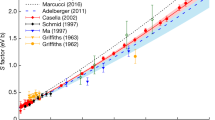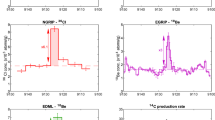Abstract
The chemical compositions of the Sun and meteorites are the benchmarks against which the abundances of elements in all other astronomical objects are compared. A long-standing problem1 has been the abundance of lithium in the Sun's photosphere, which is ∼140 times less than the meteoritic value (which represents the lithium abundance at the time the Solar System formed). This depletion requires that material from the photosphere be transported below the convective zone into regions where the temperature is high enough that nuclear processing can remove lithium. The models2,3 best able to do so simultaneously deplete beryllium by about a factor of two, which is consistent with previous measurements4,5 of the beryllium abundance in the solar photosphere. But here we show that these previous measurements are in error, because they did not fully account for the continuous opacity in the ultraviolet region of the spectrum where the beryllium lines are observed. We find that, after correcting for this opacity, solar beryllium is not depleted at all with respect to the meteoritic value. This implies that mixing in the solar photosphere is more superficial than had hitherto been supposed, consistent with the shallow mixing inferred from recent helioseismic data6.
This is a preview of subscription content, access via your institution
Access options
Subscribe to this journal
Receive 51 print issues and online access
$199.00 per year
only $3.90 per issue
Buy this article
- Purchase on Springer Link
- Instant access to full article PDF
Prices may be subject to local taxes which are calculated during checkout


Similar content being viewed by others
References
Pinsonneault, M. H. Mixing in stars. Annu. Rev. Astron. Astrophys. 35, 557–605 (1997).
Pinsonneault, M. H., Kawaler, S. D., Sofia, S. & Demarque, P. Evolutionary models of the rotating sun. Astrophys. J. 338, 424–452 (1989).
Richard, O., Vauclair, S., Charbonnel, C. & Dziembowski, W. A. New solar models including helioseismological constrains and light-element depletion. Astron. Astrophys. 312, 1000–1011 (1996).
King, J. R., Deliyannis, C. P. & Boesgaard, A. M. The 9Be abundances of alpha centauri A and B and the sun: Implications for stellar evolution and mixing. Astrophys. J. 478, 778–786 (1997).
Primas, F., Duncan, D. K., Pinsonneault, M. H., Deliyannis, C. P. & Thorburn, J. A. Hubble Space Telescope beryllium abundances in the alpha centauri system. Astrophys. J. 480, 784–793 (1997).
Basu, S. Seismology at the base of the solar convective zone. Mont. Not. R. Astron. Soc. 288, 572–584 (1997).
Gustafsson, B. & Bell, R. A. The colours of G and K type giant stars. I. Astron. Astrophys. 74, 313–352 (1979).
Kurucz, R. L. Finding the “missing” solar ultraviolet opacity. Rev. Mex. Astron. Astrofis. 23, 181–194 (1992).
Bell, R. A., Paltoglou, G. & Tripicco, M. J. The calibration of synthetic colours. Mon. Not. R. Astron. Soc. 268, 771–792 (1994).
Holweger, H. Depression of the solar continuous spectrum by line absorption and Balmer continuum. Astron. Astrophys. 4, 11–17 (1970).
Grevesse, N. & Sauval, A. J. in Molecules in the Stellar Environment (ed. Jorgensen, U. G.) 196–208 (IAU Colloq. 146, Springer, Berlin, 1994).
Bauschlicher, C. W. J & Langhoff, S. R. Theoretical determination of the radiative lifetime of the A2Σ+ state of OH. J. Chem. Phys. 87, 4665–4672 (1987).
Kurucz, R. L., Furenlid, I., Brault, J. & Testerman, L. Solar Flux Atlas from 296 to 1200 nanometers (Natl Solar Observatory, Tucson, 1984).
Holweger, H. & Müller, E. A. The photospheric barium spectrum — Solar abundance and collisional broadening of Ba II lines by hydrogen. Solar Phys. 39, 19–30 (1974).
Kurucz, R. L. Atlas 9 Stellar Atmosphere Programs and 2em/s Grid CD-ROM No. 13(Smithsonian Astrophys. Observatory, 1993).
Edvardsson, B. et al. The chemical evolution of the galactic disk — part one — analysis and results. Astron. Astrophys. 275, 101–152 (1993).
Grevesse, N., Sauval, A. J. & van Dischoeck, E. F. An analysis of vibration-rotation lines of OH in the solar infrared spectrum. Astron. Astrophys. 141, 10–16 (1984).
Seaton, M. J., Yan, Y., Mihalas, D. & Pradhan, A. K. Opacities for stellar envelopes. Mon. Not. R. Astron. Soc. 266, 805–828 (1994).
Dragon, J. N. & Mutschlecner, J. P. The Solar Ultraviolet Continuum. Astrophys. J. 239, 1045–1069 (1980).
Kurucz, R. L., van Dischoeck, E. F. & Tarafdar, S. P. OH and CH continuous opacity in solar and stellar atmospheres. Astrophys. J. 322, 992–998 (1987).
Chmielewski, Y., Müller, E. A. & Brault, J. W. The solar beryllium abundance. Astron. Astrophys. 42, 37–46 (1975).
Woods, T. N. et al. Validation of the UARS solar ultraviolet irradiances: Comparison with the ATLAS1 and 2 measurements. J. Geophys. Res. D6, 9541–9569 (1996).
Kumar, P. & Quataert, E. J. Angular momentum transport by gravity waves and its effect on the rotation of the solar interior. Astrophys. J. 475, L143–L146 (1997).
Zahn, J.-P., Talon, S. & Matias, J. Angular momentum transport by internal waves in the solar interior. Astron. Astrophys. 322, 320–328 (1997).
Stark, G., Brault, J. W. & Abrams, M. C. Fourier-transform spectra of the A2Σ+ − X2II Δν = 0 bands of OH and OD. J. Opt. Soc. Am. B 11, 3–32 (1994).
Goldman, A. & Gillis, J. R. Spectral line parameters for the A2Σ+ − X2II(0,0) band of OH for atmospheric and high temperatures. J. Quant. Spectrosc. Radiat. Transfer 25, 111–135 (1981).
German, K. R. Direct measurement of the radiative lifetimes of the A2Σ+ (V′ = 0) states of OH and OD. J. Chem. Phys. 62, 2584–2587 (1974).
Wiese, W. L. & Martin, G. A. Wavelengths and Transition Probabilities for Atoms and Atomic Ions (NBS Monogr. 68, US Govt Print. Off., Washington, DC, 1980).
García López, R. J., Severino, G. & Gomez, M. T. Galactic evolution of beryllium. I. NLTE effects and accuracy of beryllium abundances in metal-poor stars. Astron. Astrophys. 297, 787–801 (1995).
Kiselman, D. & Carlsson, M. in The Light Element Abundances (ed. Crane, P.) 372–381 (Proc. ESO/EPIC Workshop, Springer, Berlin, 1995).
Acknowledgements
We thank C. Proffitt and D. Lambert for discussion. This work was supported by a NASA grant to S.C.B. and a NSF grant to R.A.B.
Author information
Authors and Affiliations
Corresponding author
Rights and permissions
About this article
Cite this article
Balachandran, S., Bell, R. Shallow mixing in the solar photosphere inferred from revised beryllium abundances. Nature 392, 791–793 (1998). https://doi.org/10.1038/33879
Received:
Accepted:
Published:
Issue Date:
DOI: https://doi.org/10.1038/33879
This article is cited by
-
Solar structure and evolution
Living Reviews in Solar Physics (2021)
-
Chemical composition of the solar surface
Journal of Astrophysics and Astronomy (2020)
-
Stellar abundances of beryllium and CUBES
Astrophysics and Space Science (2014)
-
Solar neutrino physics: Historical evolution, present status and perspectives
La Rivista del Nuovo Cimento (2002)
Comments
By submitting a comment you agree to abide by our Terms and Community Guidelines. If you find something abusive or that does not comply with our terms or guidelines please flag it as inappropriate.



